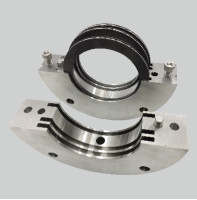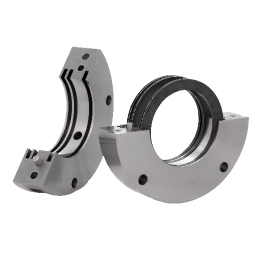Project Description
- Ease of installation during assembly
due to split design (dismantling of shaft
is not necessary) - Operational durability
- Easy to maintain
- Trouble free replacement due to
segmented seal ring design
- Bearing seals (gear box, motors)
- Chemical industry
- Food processing industry
- Fumes and exhaust,solids containing, flammable (ATEX), acid containing and toxic gases (Solids containing) steams / liquid mist Gases
- Medium-sized and large fans / blowers
- Metal production and processing
- Mixers, agitators, mills, dryer
- Oil mist / penetrating oil
- Petrochemical industry
- Power plant technology
- Steam turbines
- Waste incineration and removal industry
- Water
- FDA
- Seal ring: Carbon, PTFE compound
- Housing: 1.4021, 1.4571, Hastelloy®, Titanium,
- Inconel®, others
- Tension spring / detent: 1.4571, Hastelloy®,
- Titanium, Inconel®
- Shaft diameter:
d = 40 … 340 mm (1.57″ … 13.39″) - Operating pressure:
p = vacuum … 20 bar (290 PSI) abs. - Operating temperature: t = -120 °C … +800 °C
(-184 °F … +1,472 °F) for carbon,
max. 225 °C (437 °F) for PTFE compound - Speed = max. 150 m/s (492 ft/s) for carbon, max. 40 m/s (131 ft/s)for PTFE compound
- Radial play: ±1.0 … 5.0 mm (±0.04″ … 0.2″)
- Axial movement: theoretically unlimited
- Recommended wear guard: >300 HB (low
pressure), >58 HRC (high pressure)
- Designed to accommodate axial shaft
movement - Capable of running dry
- Radially cut multi-part seal rings
- Shaft free of sealing components which
minimizes the shaft vibrations - Seal rings are self adjusting
- Shaft movement is accommodated by
seal rings - Minimal power consumption as seal
rings are non-contacting - Design of the seal housing is split
- Low leakage due to extremely reduced
gap during operation



